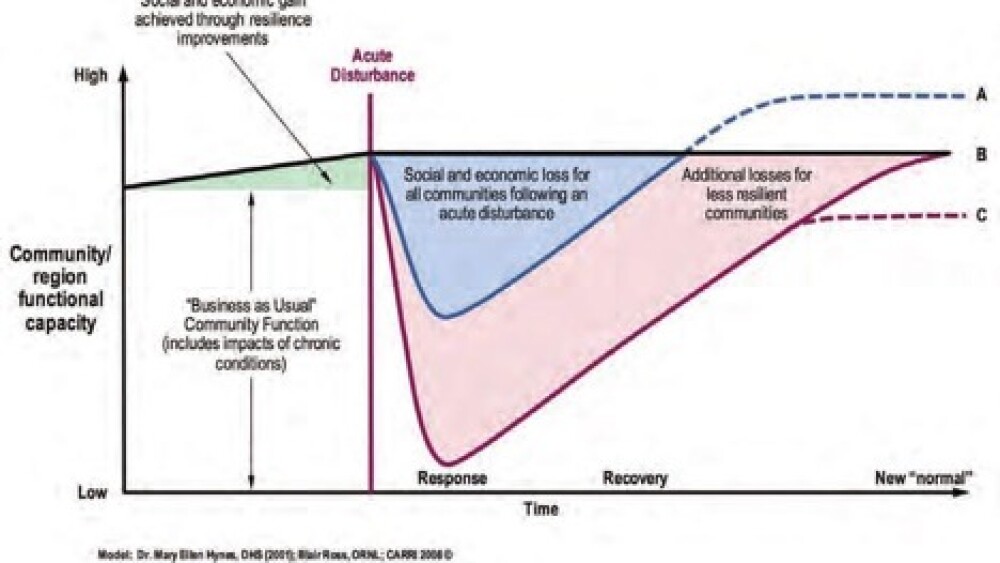By Mickey Snowdon, Communications Liaison for The Collider. This is a contributor-submitted Voices piece. Want to join the conversation? We invite you to write for us. Learn how to share your voice here.
I recently attended a webinar titled Build Back Better: Cities at the Frontlines of COVID-19 Impact and Recovery, hosted by the World Resources Institute (WRI). There were representatives from the UN, the World Bank, and international governments speaking on future financial investments for cities across the world, but I was most struck by a simple statement made by WRI’s Ani Dasgupta who said, “We actually have to do things differently in order to prevent future crises.”
This pandemic has shown our country that we’re not as strong as we thought we were—but that doesn’t mean we can’t change. A system is only as resilient as its ability to recover and adapt to a disruption, and COVID-19 has undoubtedly proven to be a disruption. Our country is now faced with a critical decision: do we rebuild our local and national communities back to their pre-COVID states, or do we redesign them better so that they can withstand future crises?
The coronavirus is the effect of our broken economic, environmental, and social systems. Is a public health outbreak really that “uncertain” when humans are constantly over-developing wildlife habitats, unleashing a host of unknown viruses? Is it really that surprising that it’s difficult for hospitals to treat patients when the number of hospital beds in the US has been declining for decades? And is it really that surprising that once again it’s African Americans who are disproportionately affected by a health crisis?

Deforestation is one of many ways humans encroach on wildlife. Photo courtesy Meritt Thomas on Unsplash
In short, social and economic disparities, unequal access to healthcare, urbanization, and climate change have created the perfect storm for communicable diseases to not only develop and spread but to cripple our existing systems. And like climate change, no one is truly safe. In order to build more resilient communities, we have to address these systemic causes.
Another way to think about resilience is in terms of capacity. Part of what it means to build resilience within a community or system is to increase capacity for a future disruption. In the resilience curve pictured below, option A is the only option where capacity is built into a community’s recovery. Capacity is important because it gives a community time to react and resources to leverage. Using the coronavirus as an example, imagine how different our country’s reaction would have been if we’d been better prepared for a pandemic.

This resilience curve provides three options for recovery: A, B, and C. A is the only recovery option where a community would actually build more resilience than it had pre-disruption. Figure courtesy White et al.
But our country’s reaction to COVID-19 wasn’t all bad. One positive example of resilience we saw across the US was the willingness and innovation of companies to convert their operations to produce medical supplies. 3M began making masks and local distilleries everywhere began producing hand sanitizer (I’m looking at you, Cultivated Cocktails). While it’s important to look at what we didn’t do right, it’s equally beneficial to take note of how we adapted.
I’ve seen resilience first-hand in my organization, The Collider, an Asheville, NC-based non-profit network of member businesses, organizations, and academic and government institutions advancing climate solutions for all. When Governor Cooper first announced the Stay at Home mandate, I was genuinely worried that The Collider would slowly die. Instead, our members have pulled together to sustain our network by continuing their memberships even though they can’t currently access our physical office space. I thought the camaraderie of working together on climate issues would also be lost, but to my amazement, various individuals have taken it upon themselves to collaborate on climate webinars.
We’ve also had support from the Asheville community. We were able to partner with the Asheville Museum of Science to present their monthly Science Pub event (March’s was on the dangerous household gas, radon) via Zoom. Other local and national organizations like the Citizens Climate Lobby and Asheville Greenworks have been more than willing to help us stream their films, originally slated to be viewed at The Collider, online.
The Collider has been fortunate to have the support of our members and our community to adapt to COVID-19, but this pandemic has shown us that it’s imperative we build resilience in preparation for future disruptions. While we’re still fleshing out what this means for us, we’re sure it will necessitate collaboration. I’m grateful to be part of a network and a community that is willing to help one another during such a challenging time. #AshevilleStrong.

